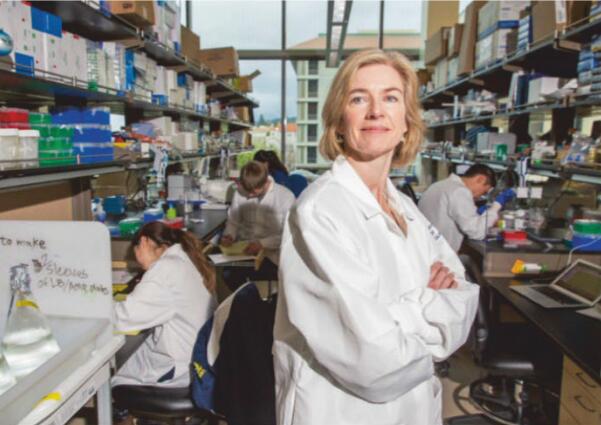Both teams made use of "jumping genes" or transposons (often called selfish genes),
兩個(gè)團(tuán)隊(duì)都利用“跳躍基因”或轉(zhuǎn)座因子(常被稱為自私的基因)
which are pieces of DNA that seem to hop around genomes with little more purpose than to proliferate.
它們是DNA的片段,且似乎在基因組間跳躍,除了增殖之外,幾乎沒有其他目的。
They were thought to do so aimlessly but, in 2017,
它們的跳躍被認(rèn)為是毫無意義的,但在2017年,
it was discovered that some contained gene-editing systems that were very good at recognising specific DNA sequences.
一些含有基因編輯系統(tǒng)的跳躍基因被發(fā)現(xiàn)非常善于識別特定的DNA序列。
These were able to control where the jumping genes landed.
這些能夠控制跳躍基因著陸的地點(diǎn)。
That, in turn, led to the idea, says Dr Sternberg, that it might be possible to harness jumping genes in gene editing.
Sternberg博士表示,反過來,這引發(fā)了這種想法—或許可以在基因編輯中利用跳躍基因。
Dr Zhang and Dr Sternberg have now demonstrated programmable CRISPR-Cas gene-editing systems
張博士和Sternberg博士現(xiàn)已表明可編輯CRISPR-Cas基因編輯系統(tǒng)
that do just this by harnessing a protein encoded by a jumping gene known as Tn7.
通過利用一種被稱為Tn7的跳躍基因編碼的蛋白質(zhì)來做到這一點(diǎn)。
Dr Sternberg says that instead of making a double-stranded cut to DNA, and waiting for the cell to repair itself,
Sternberg博士表示不是對DNA進(jìn)行雙鏈切割,而是等待細(xì)胞自我修復(fù),
in the new system the act of insertion happens at the same time a cut is made.
在新系統(tǒng)中,嵌入動(dòng)作與切割動(dòng)作同時(shí)發(fā)生。
Because the transposon method of gene editing does not need a cell's own repair mechanisms to conduct and make good the edit,
因?yàn)榛蚓庉嫷霓D(zhuǎn)位子方法不需要細(xì)胞的自我修復(fù)機(jī)制就能指導(dǎo)并做好編輯工作,

it offers a mechanism for adding genes into a wider variety of cells.
它為將基因添加至更多種類的細(xì)胞提供了一種機(jī)制。
This includes neurons and, most critically, cells that are not currently replicating in a suitable way for CRISPR to work.
這包括神經(jīng)細(xì)胞以及更關(guān)鍵的是,目前不能適合CRISPR工作方式進(jìn)行復(fù)制的細(xì)胞。
Although the new papers only demonstrate that jumping-gene editing works in bacteria,
雖然新論文僅論證了細(xì)菌中跳躍基因的編輯工作,
scientists have high hopes that it might work in human cells.
但科學(xué)家對其在人類細(xì)胞中的應(yīng)用抱有很高期待。
The news is welcome in a field where the potential applications in medicine seem to grow by the day.
這一消息在潛在應(yīng)用日益增長的醫(yī)學(xué)界受到歡迎。
Verve Therapeutics, a biotech firm in Cambridge, Massachusetts,
馬薩諸塞州坎布里奇的一家生物技術(shù)公司Verve Therapeutics
recently said that it wanted to use genetic editing to protect patients from coronary heart disease.
近期表示其希望利用基因編輯技術(shù)預(yù)防冠心病。
CRISPR Therapeutics, based in Zug, Switzerland, wants to edit beta cells, which produce insulin,
位于瑞士楚格的CRISPR Therapeutics希望編輯生產(chǎn)胰島素的beta細(xì)胞,
so that they can be transplanted into diabetics without rejection.
這樣它們就可以被移植到糖尿病患者體內(nèi)而不產(chǎn)生排斥反應(yīng)。
In all these therapies, regulators will have to assess the risks and benefits.
在所有這些療法中,監(jiān)管者將需要評估風(fēng)險(xiǎn)和益處。
That will be easier when small risks of mistakes are set against the benefits of curing a fatal disease.
當(dāng)錯(cuò)誤的小風(fēng)險(xiǎn)與治愈致命疾病的好處相抵消時(shí),這將會更容易。
But if CRISPR is to be used more widely and safely,
但如果CRISPR的用途更加廣泛更加安全,
more understanding will be needed of how genetic changes actually relate to differences in how a cell functions.
我們則需要更多的理解基因改變和細(xì)胞功能差異的聯(lián)系。
That effort got a boost this week. Jennifer Doudna of the University of California, Berkeley,
本周該努力得到了推動(dòng)。CRISPR-Cas基因編輯的發(fā)現(xiàn)者,該領(lǐng)域頂尖科學(xué)家
who discovered CRISPR-Cas gene editing and is a leading scientist in the field,
伯克利加利福尼亞大學(xué)的Jennifer Doudna
will collaborate with GSK, a drugs firm based in London, to elucidate the basic science of gene editing.
將和位于倫敦的一個(gè)藥物公司GSK合作闡明基因編輯的基礎(chǔ)科學(xué)。
The new Laboratory for Genomic Research, based in San Francisco,
Genomic Research的新實(shí)驗(yàn)室位于舊金山
is a $67m five-year collaboration that may ultimately be useful for drug development and would-be gene editors
耗資6700萬美元,合作期為5年,或許這次合作最終有助于藥物開發(fā)并幫助潛在的基因編輯者
—whether they seek to make changes to adults or embryos.
—不論他們想改變的是成人還是胚胎。
譯文由可可原創(chuàng),僅供學(xué)習(xí)交流使用,未經(jīng)許可請勿轉(zhuǎn)載。



